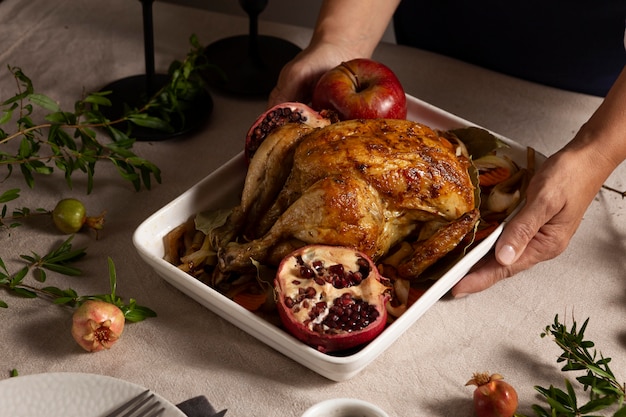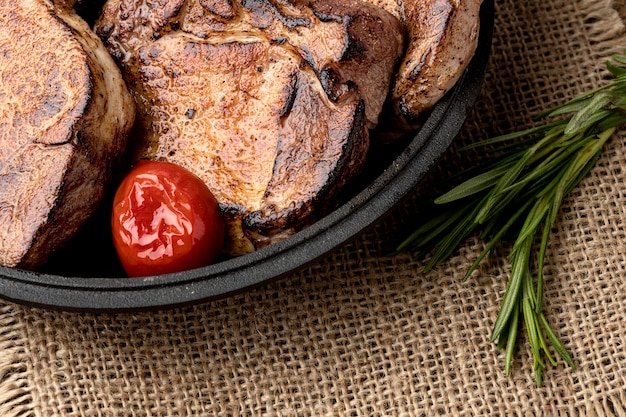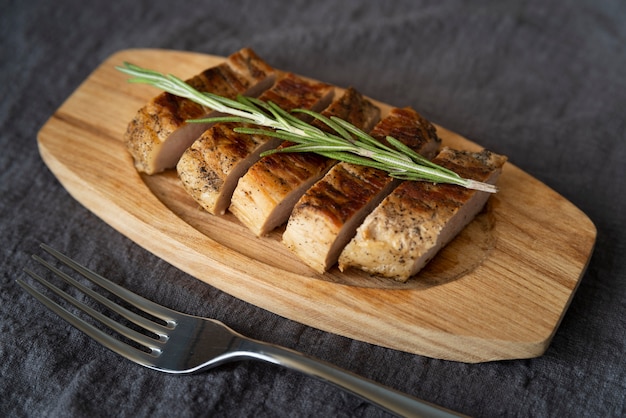Let's be real, there's nothing quite like a perfectly cooked filet mignon. That tender, melt-in-your-mouth texture, the rich, savory flavor – it's pure culinary bliss. For years, I've been honing my oven-baked filet mignon skills, and believe me, it's a game worth playing. From the perfect sear to the juicy, succulent interior, I'm sharing all the secrets I've learned along the way. This isn't just a guide; it's a love letter to the deliciousness that is a perfectly cooked filet mignon. So, grab a glass of your favorite red, put on your comfy cooking clothes, and let's embark on this culinary journey together!
(Part 1) Getting Started: choosing the right steak

Okay, let's face it, the quality of your steak truly matters. You want a filet mignon that's reliable, that delivers on its promise of juicy tenderness and rich flavor. So, let's start with the basics – selecting the perfect steak.
Picking Your perfect filet mignon
My go-to is always a center-cut filet mignon. It's the most tender and flavorful part of the whole cut, and it holds its shape beautifully during cooking. I usually aim for a steak that's about 1.5 inches thick, giving it enough heft to retain moisture while cooking. Think of it like this – you want a steak that's substantial enough to stand up to the heat and still be juicy and tender inside.
Now, if you're feeling adventurous and want to take things up a notch, go for a dry-aged filet mignon. Yes, it's a bit pricier, but trust me, the flavor is absolutely worth it! The aging process gives the steak a more intense, complex taste, a wonderful crusty exterior, and a unique, almost nutty aroma. You can find dry-aged filets at most good butcher shops or even some specialty supermarkets. It's definitely a treat if you're willing to splurge!
The Temperature Matters
It might seem like a small detail, but taking your steak out of the fridge about 30 minutes before cooking is essential. This allows the steak to come up to room temperature, helping it cook more evenly throughout. Don't worry, this isn't going to spoil the meat; it's just going to make it cook better, allowing for a more tender and delicious result.
(Part 2) Prepping the Steak: A Little TLC

Time to get our hands dirty (in a good way)! It's time to give our prized filet mignon some TLC before we send it to the oven.
Seasoning: The Key to Flavor
Here's where I get a little obsessed. Salt and pepper are the staples, but a good steak deserves more than just the basics, don't you think? For a classic filet mignon, I recommend a simple combination of salt, pepper, and garlic powder. A pinch of paprika or a whisper of rosemary can add beautiful complexity to the flavor.
The key here is to season generously. Don't be shy! You want that flavor to penetrate the meat and develop a beautiful crust. And remember to season on both sides!
The Fat Factor: Adding Richness and Flavor
If you're feeling adventurous, you can add a little layer of fat to your steak. I'm talking about things like butter, bacon fat, or even a drizzle of olive oil. This creates a beautiful, crispy crust and helps lock in the moisture of the steak. You can simply rub the fat onto the surface of the steak, or if you're feeling fancy, you can make a compound butter with herbs and spices. This adds a luxurious touch and infuses the steak with even more flavor.
For example, try mixing softened butter with fresh thyme, minced garlic, and a touch of lemon zest for a herby, garlicky flavor. Or, for a smoky kick, use a mixture of bacon fat, smoked paprika, and a pinch of cayenne pepper.
Don't Overdo It: A Gentle Touch
Remember, less is more when it comes to prepping your filet mignon. We don't want to overwork the meat, just give it a little love before we send it to the oven. A gentle touch is key to maximizing its tenderness and flavor.
(Part 3) The Oven: Our Steak's New Home

Time to move our perfectly prepped filet mignon into its new home – the oven! But before we do that, let's talk about the oven settings and some insider tips for maximizing the cooking process.
The Right Temperature: Unlocking the Perfect Cook
The ideal temperature for baking a filet mignon is 400°F (200°C). This creates a nice, even heat that cooks the steak perfectly without drying it out. You can use a regular oven or a fan-forced oven, just make sure you’re comfortable with the settings of your oven.
The Oven Rack: Finding the Sweet Spot
Place a baking sheet in the middle rack of your oven. We don't want the steak to be too close to the heating element or too far away from it. The middle rack ensures even cooking from all sides.
(Part 4) The Sear: Adding a Touch of Magic
Here's where things get exciting! We're going to give our filet mignon a little love in the form of a delicious sear. This step creates that beautiful, crispy crust that elevates the steak from good to unforgettable.
The Searing Technique: Creating a Perfect Crust
Before you put the steak in the oven, heat a cast iron skillet or a heavy-bottomed pan over high heat. You want it to be screaming hot! Then, add a little bit of oil to the pan – I usually use olive oil, but you can use any oil with a high smoke point.
Once the pan is smoking hot, carefully place the steak in the pan. You'll hear a nice sizzling sound as the steak hits the pan, and you'll see the edges start to brown. This is what we're looking for!
Get Those Beautiful Sear Marks: Adding Depth and Flavor
You want to sear the steak for about 2 minutes per side. Don't be afraid to use tongs to gently press down on the steak and get a nice crusty sear on all sides. This will give it that amazing look and flavor we're aiming for!
Remember, you want a beautiful, even crust on all sides of the steak, not just the top and bottom. It's worth taking a minute to carefully sear the edges as well.
Don't Forget the Sides: Even Cooking for a Perfect Result
Don't forget to sear the edges of the steak, too! This is called a "reverse sear" and it's a really good way to cook the steak evenly. The heat from the sear helps to penetrate the meat and create a more consistent internal temperature. It's like a little secret ingredient for perfect cooking!
(Part 5) The Bake: Time to Relax and Let the Oven Work Its Magic
Okay, we've done the hard work. Now, we just need to let the oven do its magic!
Baking Time: The Key to Perfect Doneness
Place the seared steak on the baking sheet in the oven. This is where the magic happens! The oven will cook the steak to your desired level of doneness. Here's where knowing your baking times comes in handy:
| Doneness | Internal Temperature | Baking Time |
|---|---|---|
| Rare | 125°F - 130°F (52°C - 54°C) | 6-8 minutes |
| Medium Rare | 130°F - 135°F (54°C - 57°C) | 8-10 minutes |
| Medium | 135°F - 140°F (57°C - 60°C) | 10-12 minutes |
| Medium Well | 140°F - 145°F (60°C - 63°C) | 12-14 minutes |
| Well Done | 145°F - 150°F (63°C - 66°C) | 14-16 minutes |
Of course, these are just guidelines. The actual baking time will depend on the thickness of your steak and your oven. I always use a meat thermometer to check the internal temperature of the steak. You can find a meat thermometer at most kitchen stores or online.
Rest Time: A Little Patience for Maximum Tenderness
Once the steak is cooked to your liking, take it out of the oven and let it rest for 5-10 minutes before slicing and serving. This allows the juices to redistribute throughout the steak, ensuring it's incredibly tender and juicy. You can cover the steak with foil to keep it warm while it rests. This is a crucial step that many people forget. It's like giving the steak a little spa treatment before serving, allowing it to relax and soak in all its juices.
(Part 6) The Finish: Adding the Final Touches
We're almost there! The steak is cooked, it's resting, and now it's time to add that final flourish.
Add Some Butter: A Touch of Richness
I love to add a pat of butter to my filet mignon while it's resting. This adds an extra layer of richness and flavor, melting into the steak as it rests, infusing it with a buttery goodness. You can even add some chopped herbs to the butter for an extra touch of magic.
For example, a classic combination is butter with fresh thyme and rosemary. Or, for a more savory twist, try butter with minced garlic and a sprinkle of smoked paprika.
Sauce It Up: Elevating the Flavor Profile
A good sauce can really elevate a filet mignon. My favorite is a simple red wine reduction sauce. You can also use a béarnaise sauce, a mushroom sauce, or even a creamy garlic sauce. You can find countless recipes online or in your favorite cookbooks. The key is to choose a sauce that complements the flavors of your steak.
For example, a red wine reduction sauce pairs beautifully with a classic filet mignon, while a béarnaise sauce adds a rich, tangy flavor that complements the buttery notes of the steak.
(Part 7) Serving Your Masterpiece: The Grand Finale
Okay, the moment of truth is here! It's time to reveal your masterpiece to the world.
The Presentation: Creating a Stunning Dish
For a classic presentation, slice the filet mignon into 1-inch thick pieces. I like to serve it on a bed of mashed potatoes or creamy risotto. You can also add some roasted vegetables or a salad on the side.
For a more modern presentation, try serving the steak sliced on a bed of arugula with a drizzle of balsamic glaze and a sprinkle of Parmesan cheese.
The Garnishes: Adding a Touch of Elegance
If you're feeling fancy, you can add some garnishes to your plate. A sprig of rosemary, a slice of lemon, or even a few fresh berries can add a touch of elegance to your meal.
For a rustic touch, try adding a few sprigs of fresh thyme or a sprinkle of fresh parsley. Or, for a more vibrant presentation, use a few slices of red onion or a sprinkle of pomegranate seeds.
The Enjoyment: Savoring the Fruits of Your Labor
And finally, the best part – enjoy! Take a moment to appreciate the hard work you've put in. Enjoy the taste of a perfectly cooked filet mignon. You deserve it!
(Part 8) Beyond the Basics: Experimenting with Flavors
Now, we've covered the fundamentals, but the beauty of cooking is that it's an ongoing adventure. Here are some ideas to take your filet mignon to the next level.
Spice It Up: Embracing Bold Flavors
Get creative with your seasoning! You can use a blend of different spices, herbs, or even a dry rub. I've experimented with everything from Cajun spices to smoked paprika, and each time, it's a delicious surprise.
For example, try a simple blend of smoked paprika, chili powder, cumin, and garlic powder for a smoky, spicy kick. Or, for a more exotic flavor, use a blend of ginger, turmeric, coriander, and garam masala.
Upgrade Your Sear: Taking Things to the Next Level
If you're feeling adventurous, try a pan-searing technique called "reverse searing". You cook the steak to medium-rare in the oven, then sear it over high heat for a few minutes to get that perfect crust. This creates a steak that's cooked evenly and has a beautiful sear. It's a bit more involved, but the results are worth it!
Embrace the Sides: Complementary Flavors
Don't be afraid to experiment with different sides. You can try roasted vegetables, mashed potatoes, creamy risotto, or even a gourmet pasta dish. I also love to serve filet mignon with a side salad or a simple green bean casserole.
For a classic combination, try roasted asparagus with lemon and garlic, or a creamy potato gratin. For a more modern approach, try a quinoa salad with roasted vegetables and a light vinaigrette.
(Part 9) FAQs: Solving Your Filet Mignon Mysteries
Let's face it, there are always some lingering questions when it comes to cooking. Here are some answers to the most common questions about cooking filet mignon in the oven.
1. How do I know if my filet mignon is cooked to the right temperature?
The best way to know is to use a meat thermometer. Insert the thermometer into the thickest part of the steak and make sure it reaches your desired internal temperature. You can find meat thermometers at most kitchen stores or online.
2. What if my filet mignon is too thick?
If your filet mignon is thicker than 1.5 inches, you might need to adjust your cooking times. It's best to use a meat thermometer to check the internal temperature and ensure it's cooked to your liking. You might also want to consider using a lower oven temperature to prevent the steak from overcooking.
3. Can I cook my filet mignon in a cast iron skillet?
Absolutely! You can actually cook the entire filet mignon in a cast iron skillet on the stovetop. Just heat the skillet over medium-high heat, add some oil, and cook the steak for about 4-5 minutes per side. Use a meat thermometer to check the internal temperature and make sure it's cooked to your liking.
4. What are some good side dishes for filet mignon?
The possibilities are endless! You can try roasted vegetables, mashed potatoes, creamy risotto, or even a gourmet pasta dish. I also love to serve filet mignon with a side salad or a simple green bean casserole.
5. How long can I store leftover filet mignon?
You can store leftover filet mignon in the refrigerator for up to 3-4 days. Make sure to wrap it tightly in plastic wrap or aluminum foil to prevent it from drying out. You can reheat it in the oven or on the stovetop. Just be sure not to overcook it!
So, there you have it! Your ultimate guide to perfectly cooked filet mignon in the oven. It's a simple yet elegant dish that's sure to impress your guests. So, go forth and cook with confidence! And remember, the most important thing is to have fun!
Everyone is watching

Corn on the Cob: The Ultimate Guide to Perfectly Cooked Ears
Healthy MealsAh, corn on the cob. Just the name evokes images of sunny days, barbecues, and that sweet, juicy flavour that ...

Scallops: The Ultimate Guide to Perfect Cooking
Healthy MealsAh, scallops. Those delicate, sweet, and utterly delicious morsels of the sea. They hold a special place in my...

Spaghetti Squash: The Ultimate Guide to Cooking and Serving
Healthy MealsRemember that time you saw spaghetti squash at the supermarket, looking all bumpy and strange, and thought, "W...

Salmon Cooking Times: Perfect Guide for Every Recipe
Healthy MealsLet me tell you, cooking salmon is an art form. It's all about getting that perfect balance: juicy and tender,...

Ham Cooking Time: How Long to Bake, Smoke, or Boil a Delicious Ham
Healthy MealsAh, ham. It's a classic, isn't it? A real crowd-pleaser, especially around holidays. And when done right, it'...
